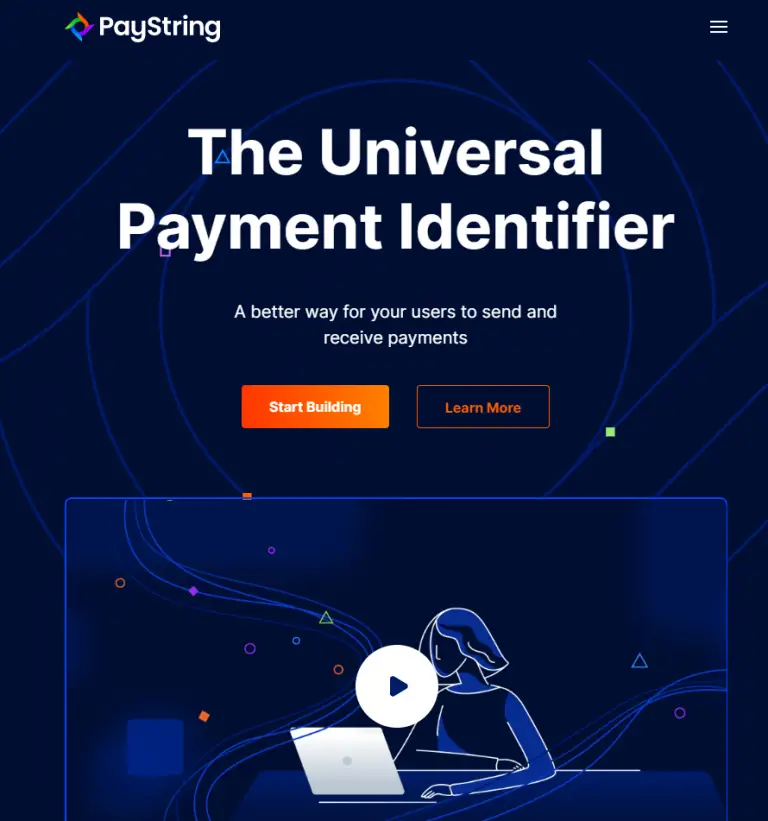What is PayString?
PayString is an open-source payment identifier developed by the blockchain technology company Ripple, launched in 2020. It is designed to facilitate the sending and receiving of various types of cryptocurrencies, simplifying the process of currency payments across different payment networks or currencies. Unlike traditional payment methods, PayString provides a single, specific ID to the recipient, making it easy to create a memorable and straightforward payment identifier usable across multiple networks. This enhances interoperability between different payment systems, bolsters security, and reduces payment costs.
PayString’s Key Features & Benefits
- Simplified payment identification: PayString enables users to generate a single, easy-to-remember payment identifier that works across various payment networks and currencies. This streamlines the management and sharing of payment information.
- Promotes interconnection of payment methods: Regardless of the technology or method, PayString allows different payment networks to communicate and trade more easily, reducing the need for complex integrations and intermediary controls.
- Enhanced payment security: Utilizing advanced encryption technology and other security measures, PayString protects user data and mitigates payment security risks.
- Reduces payment costs: By eliminating the need for multiple intermediaries, PayString reduces the time and resources required for payments, offering faster, cheaper, and more efficient transactions.
- Improves payment transparency: PayString can automatically monitor transaction information, increasing the transparency of the payment process and bolstering user trust and confidence.
PayString’s Use Cases and Applications
PayString can be utilized across a variety of industries and sectors due to its versatile nature. Here are some specific examples of how it can be used:
- Cross-border payments: Businesses dealing with international clients or suppliers can use PayString to simplify and expedite cross-border transactions.
- Freelance payments: Freelancers can benefit from a single, easy-to-share payment identifier, making it easier to receive payments from clients across different platforms.
- Cryptocurrency exchanges: Exchanges can utilize PayString to streamline the process of sending and receiving various cryptocurrencies.
PayString’s ability to support multiple currencies and networks makes it particularly valuable in sectors like finance, e-commerce, and international trade.
How to Use PayString
Using PayString is straightforward. Here’s a step-by-step guide:
- Sign up: Register for a PayString account through a participating platform or service provider.
- Create a PayString: Generate a unique, easy-to-remember PayString identifier that you can use across different networks and currencies.
- Link payment methods: Connect your various payment methods (e.g., bank accounts, crypto wallets) to your PayString identifier.
- Share your PayString: Provide your PayString to individuals or businesses to receive payments.
Tips and Best Practices: Ensure that you use a secure and reputable platform to manage your PayString account. Regularly monitor your transactions to maintain transparency and security.
How PayString Works
PayString operates by utilizing blockchain technology to create a universal payment identifier. Here’s an overview of its technical workings:
- Payment Identifier Creation: Users generate a unique PayString identifier, which is associated with their various payment methods.
- Advanced Encryption: PayString employs advanced encryption techniques to secure transaction data and protect user privacy.
- Interoperability: The system is designed to facilitate seamless transactions across different payment networks, currencies, and technologies, ensuring broad compatibility.
The workflow involves creating a PayString, linking payment methods, and using this identifier to send or receive payments, all while maintaining high security and transparency standards.
PayString Pros and Cons
Advantages:
- Streamlines payment processes with a single identifier
- Enhances security through advanced encryption
- Reduces transaction costs by eliminating intermediaries
- Increases transparency and user trust
Potential Drawbacks:
- May require initial setup time to link multiple payment methods
- Varied pricing based on specific transaction needs
User Feedback: Users have generally praised PayString for its ease of use, enhanced security features, and ability to simplify complex payment processes. Some users, however, have noted the need for more widespread adoption to fully realize its potential.
PayString Pricing
PayString does not have a standardized pricing structure. Costs can vary depending on the specific needs of users, including the value, quantity, and type of cryptocurrencies involved in transactions. This flexible pricing model allows users to tailor their use of PayString to their specific requirements, potentially offering better value for money compared to traditional payment methods.
Conclusion about PayString
PayString offers a compelling solution for simplifying and securing cryptocurrency payments across various networks and currencies. Its key features, including simplified payment identification, enhanced security, and reduced costs, make it a valuable tool for businesses and individuals alike. While it has some potential drawbacks, such as the need for initial setup and varied pricing, the overall benefits and positive user feedback suggest that PayString is a worthwhile investment for those looking to streamline their payment processes.
As blockchain technology continues to evolve, PayString is likely to see further developments and updates, enhancing its functionality and expanding its use cases.
PayString FAQs
- What is PayString?
- PayString is an open-source payment identifier developed by Ripple, designed to simplify cryptocurrency payments across multiple networks and currencies.
- How do I create a PayString?
- You can create a PayString by registering through a participating platform or service provider and generating a unique identifier.
- Is PayString secure?
- Yes, PayString employs advanced encryption and other security measures to protect user data and ensure secure transactions.
- What are the costs associated with using PayString?
- PayString does not have a unified pricing structure; costs vary based on transaction specifics, such as the type and quantity of cryptocurrencies involved.










